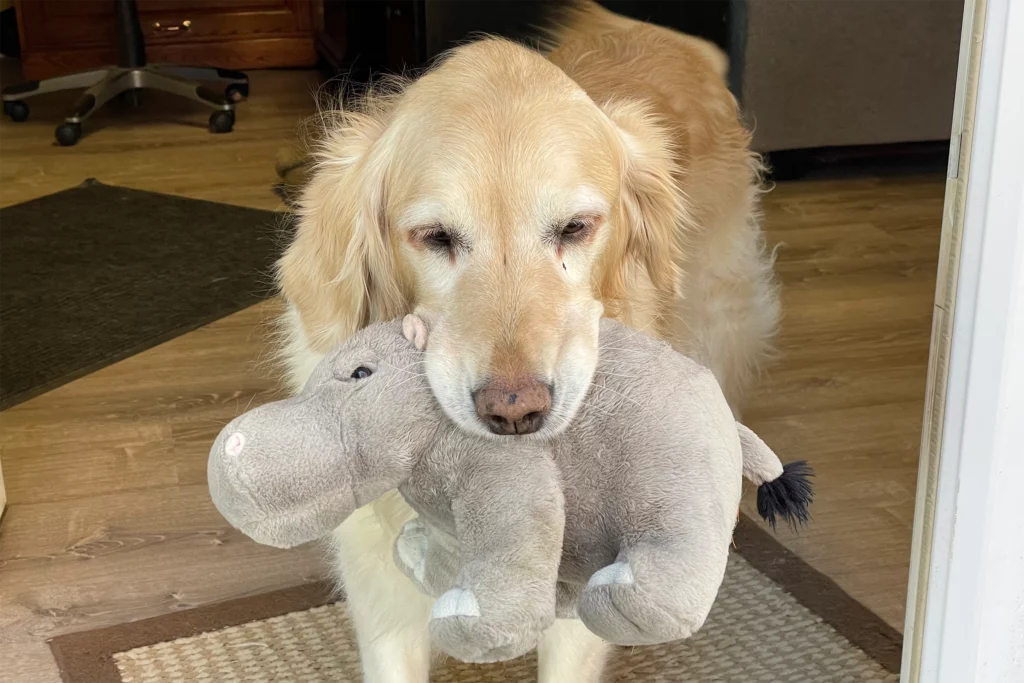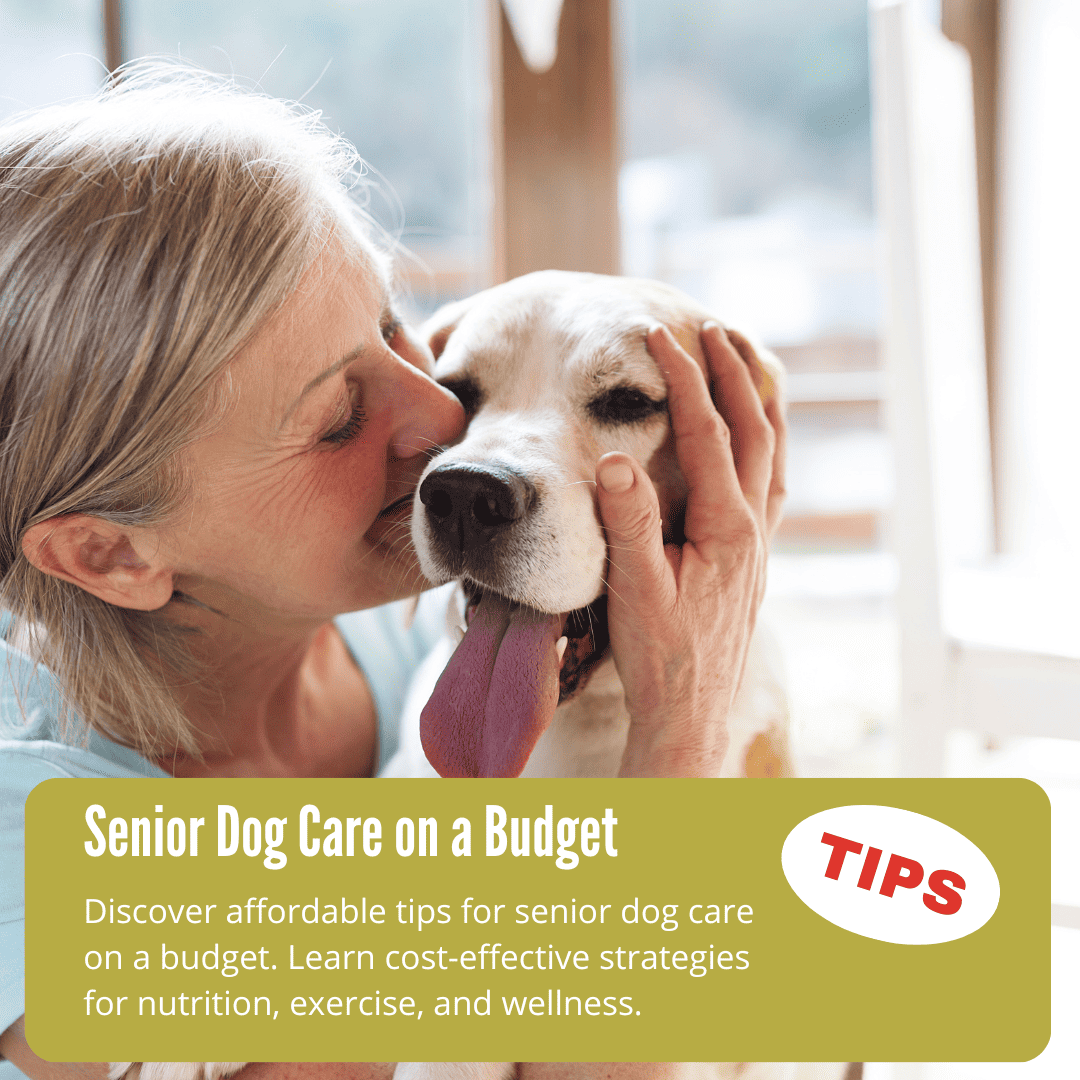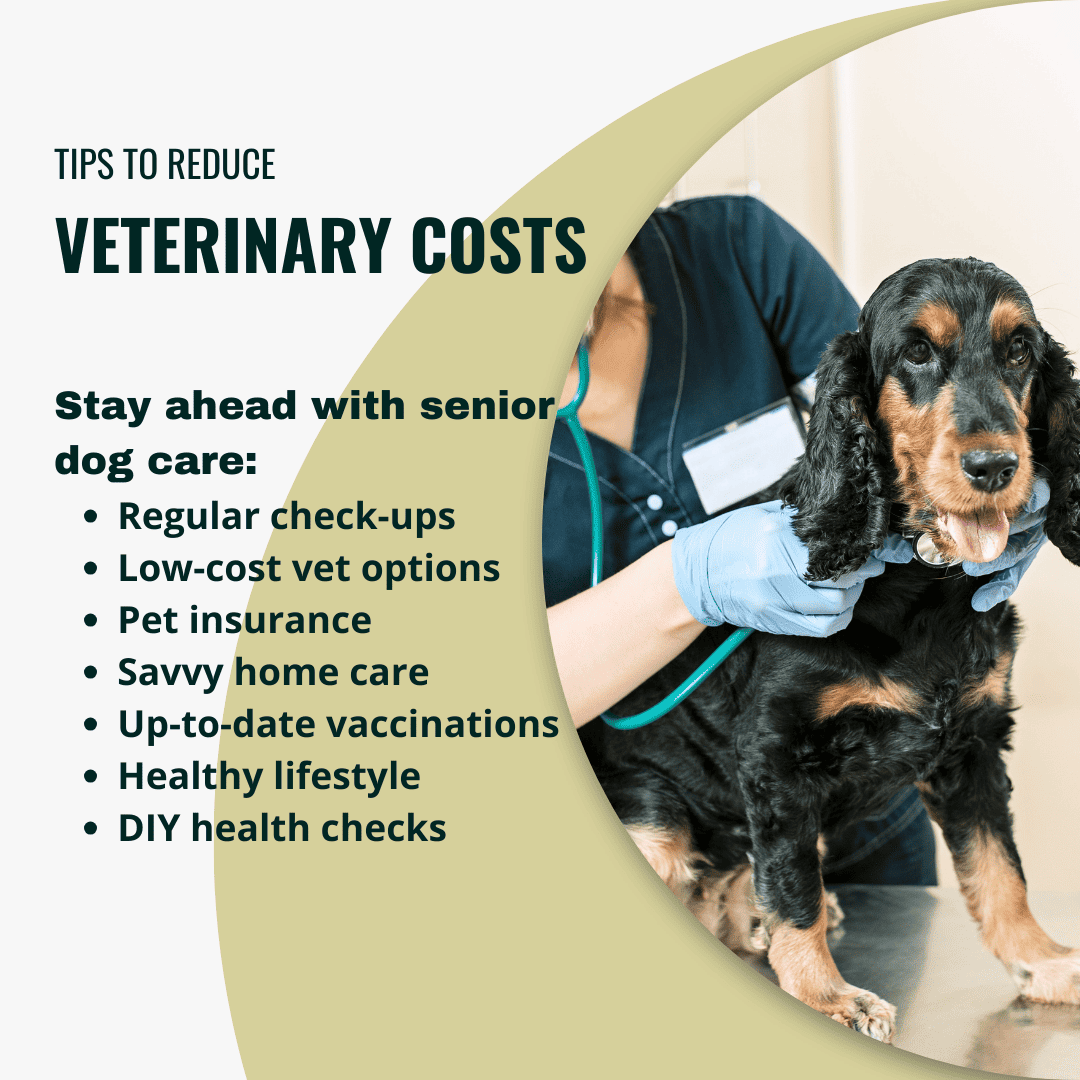This post may contain ads and affiliate links and we may earn a small commission when you click on the links at no additional cost to you. As an Amazon Affiliate, we earn from qualifying purchases. You can read our full disclaimer here.
Senior Dog Care on a Budget: Affordable Tips to Help Aging Dogs

When it comes to senior dog care on a budget, it’s all about being smart with your choices.
As our dogs get older, their needs change, and so do our strategies to look after them. But don’t worry, taking great care of your aging pup doesn’t have to empty your wallet.

Senior Dog Care on a Budget: Affordable Nutrition and Supplements
Navigating the world of nutrition and supplements for senior dogs can be tricky, especially when you’re trying to keep costs down.
As dogs age, their dietary needs change, requiring more attention to joint health, digestive systems, and overall well-being. Fortunately, there are ways to provide high-quality nutrition without breaking the bank.
One effective strategy is to opt for human-grade supplements like fish oil and glucosamine, which are often available at lower prices in bulk stores like Costco. These supplements play a crucial role in maintaining joint health and cognitive function in senior dogs.
When it comes to dog food, the goal is to find a balance between affordability and nutritional value. Senior dog foods are formulated to be easier on older dogs’ digestive systems and often include supplements for joint health.
Sensitive stomachs can be an issue with Goldendoodles
. Read our post about it.
However, they can be pricey.
An alternative is to stick with regular dog food and boost it with the necessary supplements. This approach can offer a cost-effective way to meet your dog’s dietary needs.
Tips for Budget-Friendly Nutrition and Supplements
- Compare prices and ingredients of human-grade supplements at bulk stores against pet-specific versions.
- Consult with a veterinarian to determine the right dosage of human-grade supplements for your dog’s size and health.
- Research senior dog food brands for the best combination of price and nutritional value.
- Consider adding supplements to regular dog food as an economical alternative to specialized senior dog diets.
- Check the labels for harmful additives in human supplements that might not be safe for dogs.
- Look for dog foods with natural ingredients and without excessive fillers, which are healthier for older dogs.
- Keep an eye out for sales or discounts on high-quality dog food and bulk supplement purchases.
- Stay informed about the specific nutritional needs of senior dogs, as these can differ significantly from those of younger dogs.

By taking a proactive approach to your senior dog’s nutrition and supplement needs, you can ensure they receive the care they need while managing your budget effectively.
Remember, the goal is to support your dog’s health and quality of life without overspending, and with a bit of planning and knowledge, this is certainly achievable.
Senior Dog Care on a Budget: Exercise and Activity for Senior Dogs
In senior dog care on a budget, figuring out the right exercise and activity routine is crucial. As dogs get older, their energy levels and physical abilities change.
This means adjusting their exercise routines to match their age and health. It’s not about the quantity of exercise but the quality.
Low-impact activities are the way to go, as they are gentle on aging joints but still keep your dog active and engaged. Regular, gentle exercise is essential for maintaining their health, helping with weight management, and keeping their joints mobile.
The best part? Keeping your senior dog active doesn’t have to cost a thing. There are plenty of budget-friendly ways to ensure they get the exercise they need.
Budget-Friendly Exercise Tips for Senior Dogs
- Go for multiple short walks instead of one long walk to keep it easy on their joints.
- Use household items to create simple obstacle courses for mental stimulation.
- Play gentle games like hide and seek with treats to combine exercise with brain activity.
- Swimming, if accessible, is a fantastic low-impact exercise for senior dogs.
- Regular playtime in a safe, enclosed space allows for gentle, self-paced activity.
- Incorporate simple stretching exercises into their routine to maintain flexibility.
- Explore local parks for a change of scenery and new smells, which is great for mental health.
- Schedule playdates with other senior dogs for socialization and moderate activity.
Don’t foget, the goal is to keep your senior dog moving and happy without putting too much strain on their body. And the best activities are those that you both enjoy and that bring you closer together, all while being mindful of your budget.
Senior Dog Care on a Budget: Managing Veterinary Costs

Managing veterinary costs is a critical aspect of senior dog care on a budget. As dogs age, they may require more frequent visits to the vet, which can add up quickly.
However, there are effective strategies to reduce these expenses while still ensuring your dog receives quality care.
One key approach is to be proactive about your dog’s health. Regular check-ups can help catch issues early, potentially reducing the cost and complexity of treatment.
Additionally, exploring low-cost clinics and affordable insurance options can significantly lessen the financial burden. Many communities offer low-cost veterinary services, and pet insurance can help offset some of the costs of unexpected illnesses or injuries.
Also, becoming knowledgeable about home care for common senior dog health issues can reduce the need for some vet visits.
Simple home remedies and preventive measures can go a long way in maintaining your dog’s health without incurring high costs.
Tips for Reducing Veterinary Costs
- Schedule regular check-ups to monitor health and catch issues early.
- Research low-cost veterinary clinics in your area for more affordable care.
- Consider pet insurance plans that offer coverage for senior dogs.
- Educate yourself on basic home care for common age-related issues.
- Keep up with vaccinations and preventive medications to avoid major health problems.
- Maintain a healthy diet and exercise routine to prevent obesity-related health issues.
- Learn to perform basic health checks at home, like examining ears, teeth, and paws.
By combining proactive health management, exploring cost-saving options, and increasing your home care knowledge, you can effectively manage veterinary costs for your senior dog.
This approach not only helps in saving money but also contributes to the overall well-being and longevity of your beloved pet.
Senior Dog Care on a Budget: Common Challenges in Senior Dog Care
Addressing the challenges in senior dog care on a budget starts with recognizing the common issues they face. As dogs get older, they often encounter health and behavioral changes.
These can include arthritis, vision loss, and incontinence, impacting their quality of life.
For managing arthritis, cost-effective strategies are key. Regular, gentle exercise and affordable supplements like glucosamine can help. These supplements are often cheaper in human-grade forms and can significantly improve joint health.
Vision loss in senior dogs is another challenge. To help, keep your home layout consistent. This allows your dog to navigate confidently without the need for expensive modifications.
Incontinence is a common issue as well. An effective approach involves more frequent bathroom breaks. Additionally, using washable dog diapers or bedding can be a budget-friendly solution.
Affordable Bedding Options for Older Dogs
Affordable bedding options are crucial for senior dogs, especially those with arthritis. Memory foam bedding provides excellent support and comfort for aging joints.
You can find budget-friendly memory foam dog beds, or even make your own. Consider repurposing an old memory foam mattress by cutting it to size for your dog’s bed.
You can also look for discounted memory foam pads during sales or at outlet stores. Cover them with a washable, durable fabric for easy cleaning.
The easy-to-clean, waterproof cover adds to its practicality, making it a perfect choice for senior dogs with incontinence issues. Additionally, its non-skid bottom offers extra safety to prevent slips and falls, essential for aging pets.
With various sizes available, it accommodates senior dogs of all breeds and sizes, ensuring a comfortable, supportive resting place.
Affordable Home Environment Modifications for Senior Dogs
Creating a comfortable and safe environment for your senior dog is an essential part of caring for them, especially as they age. Making some simple modifications to your home can go a long way in enhancing their quality of life.
And the good news is, it doesn’t have to be expensive. With a little creativity and some DIY solutions, you can easily adapt your space to suit their needs.
Mobility-Friendly Modifications
Senior dogs often face mobility challenges, so making your home more accessible is key. Small changes can make a big difference in how easily your dog can move around.
- Install non-slip mats or rugs in areas where your dog frequently walks to prevent slipping.
- Create DIY ramps or steps to help your dog access their favorite spots, like the couch or bed.
- Arrange furniture to create clear and easy pathways for your dog to navigate.
Resting Area Upgrades
Comfort is crucial for older dogs, especially those with joint pain or arthritis. Their resting area should be a cozy, inviting space where they can relax without discomfort.
- Provide a supportive, orthopedic bed that cushions their joints and makes getting up easier.
- Use extra pillows or blankets to create a soft, warm sleeping area.
- Position their bed in a quiet, low-traffic area of the house to reduce stress.
Feeding Area Adjustments
As dogs get older, they may find it harder to bend down to eat or drink. Making some adjustments to their feeding area can help.
- Elevate food and water bowls to reduce strain on their neck and back.
- Use non-slip mats under bowls to prevent them from moving around during mealtime.
- Choose bowls with shallow sides for easy access to food and water.
Designed to reduce joint strain and promote healthy digestion, these raised feeders offer comfortable access to food and water, especially beneficial for dogs with arthritis.
Navigational Aids for Vision Loss:
Vision loss is common in senior dogs, and a stable environment can help them feel more secure.
- Maintain a consistent layout in your home to help your dog memorize the space.
- Keep walkways clear of clutter to prevent accidents.
- Use night lights in dark areas to help your dog see better at night.
By incorporating these budget-friendly modifications, you can create a living space that caters to your senior dog’s evolving needs.
This not only ensures their comfort and safety but also enriches their day-to-day life, making their golden years as enjoyable as possible.
Senior Dog Care on a Budget: Supporting Mental and Emotional Well-Being
Caring for the mental and emotional well-being of senior dogs is just as important as their physical health, especially when working with a budget. As dogs age, they may become more prone to anxiety, depression, or cognitive decline.
Fortunately, there are many affordable ways to enrich their lives and keep their minds active and engaged.
Enriching Activities
Engaging in activities that stimulate your senior dog’s mind doesn’t have to be costly. Simple, everyday interactions can make a significant difference.
- Regular playtime, even if it’s more gentle than it used to be, keeps their mind engaged.
- Mental stimulation games, like hiding treats or using puzzle toys, can be homemade or bought at a low cost.
- Regular, short walks provide not only physical exercise but also mental stimulation from new scents and environments.
Comforting Practices
Creating a soothing environment can greatly help in maintaining your senior dog’s emotional health.
- Spend quality time with your dog, offering gentle pets and cuddles.
- Soft music or white noise can help calm dogs that may be more sensitive to loud or unfamiliar sounds.
- Maintaining a routine can provide a sense of security and familiarity, which is comforting for older dogs.
Recognizing and Addressing Distress
Being aware of changes in your dog’s behavior is crucial in identifying any mental or emotional issues.
- Watch for signs of distress or depression, such as changes in eating habits, reduced interest in play, or increased sleeping.
- Simple changes like more frequent, gentle interaction can improve their mood.
- Consult with a veterinarian if you notice significant behavioral changes. They might suggest affordable treatments or behavior modifications.
By focusing on these aspects of care, you can support your senior dog’s mental and emotional well-being without incurring high costs.
These practices not only improve their quality of life but also strengthen the bond between you and your senior companion.
Final Thoughts on Senior Dog Care on a Budget
Ultimately, the golden years of your furry friend can be filled with joy, comfort, and well-being, all achieved within a reasonable budget.
This journey with your senior dog is not just about managing their age-related challenges; it’s about celebrating their life, cherishing every moment, and providing them with a loving and comfortable environment in their twilight years.
-

Coffee Mug – In Dog Coffees I’ve Only Had One
$11.95 – $14.95 Select options This product has multiple variants. The options may be chosen on the product page


